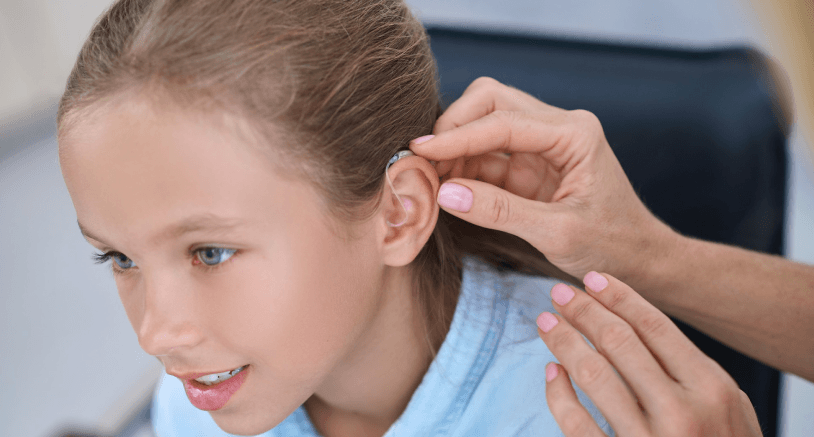
Choosing the Right Hearing Aid for Your Child: Factors to Consider
When it comes to selecting a hearing aid for your child, making the right choice is crucial. Hearing aids play a significant role in improving your child's communication abilities and overall quality of life.
However, with various options available in the market, it's essential to consider several factors to ensure you choose the most suitable hearing aid for your child's specific needs. Therefore, in this article we will explore the key factors that parents should consider when selecting a hearing aid for their child.
Understanding Your Child's Hearing Needs
Before diving into the selection process, it's vital to have a clear understanding of your child's hearing needs. Consulting with a qualified audiologist is the first step towards obtaining an accurate diagnosis and determining the extent of your child's hearing loss, a the type and severity of the hearing loss will influence the features and specifications required in a hearing aid.
Types and Styles of Hearing Aids
Hearing aids come in various types and styles, each catering to different hearing needs and preferences. Some common types include behind-the-ear (BTE), in-the-ear (ITE), and completely-in-the-canal (CIC) hearing aids: factors such as comfort, ease of use, and visibility will play a role in determining the most suitable style for your child. Additionally, consider whether your child requires a bilateral hearing aid (one for each ear) or a monaural device (one for a single ear).
Behind-the-Ear (BTE) Hearing Aids
BTE hearing aids are popular for children due to their versatility and suitability for a wide range of hearing losses. They rest comfortably behind the ear, with a tube or earmold delivering sound into the ear canal. BTE hearing aids are known for their durability and the ability to accommodate growth, making them an excellent option for the little ones.
In-the-Ear (ITE) Hearing Aids
ITE hearing aids are custom-made to fit inside the outer ear. They are more visible compared to BTE devices but still offer a discreet appearance. ITE hearing aids are suitable for mild to moderate hearing losses and provide convenient access to controls for older children who can manage their own devices.
Completely-in-the-Canal (CIC) Hearing Aids
CIC hearing aids are the smallest and most discreet hearing aids available: they fit entirely inside the ear canal, making them nearly invisible. CIC devices are suitable for mild to moderate hearing losses but may not be ideal for children with fluctuating or severe hearing loss.
Features and Functionality
Hearing aids offer a range of features and functionalities designed to enhance your child's listening experience. Consider the following factors when selecting a hearing aid for your child:
Programmability and Customization
Many modern hearing aids offer programmable settings, allowing audiologists to fine-tune the device to your child's specific hearing needs. This customization ensures optimal sound amplification and speech clarity.
Noise Reduction and Feedback Management
Hearing aids equipped with noise reduction technology help reduce background noise, enabling better speech understanding in noisy environments. On the other side, Feedback management systems prevent annoying whistling sounds, enhancing comfort during use.
Connectivity Options
Some hearing aids come with connectivity options, allowing your child to stream audio directly from compatible devices such as smartphones, tablets, or televisions. This feature can enhance their enjoyment of music, videos, and phone conversations.
Water and Dust Resistance
Consider whether your child's lifestyle or activities require a hearing aid that is water-resistant or dust-resistant. This feature can provide additional durability and reliability, especially for active children.
Comfort and Fit
Ensuring that your child's hearing aid is comfortable and well-fitted is essential for long-term use and satisfaction. Children's ears are still growing, so choosing a hearing aid with adjustable features or earmolds that can be periodically replaced is advantageous. Always remember that a proper fit will prevent discomfort and ensure optimal sound delivery.
Considerations for Growing Children
Children's hearing needs evolve as they grow, and their hearing aids should be able to adapt accordingly. Look for hearing aids that offer scalability, allowing for adjustments as their hearing requirements change. This scalability can save time and money by avoiding the need for frequent hearing aid replacements.
Cost and Insurance Coverage
Hearing aids can be a significant investment, so it's crucial to consider your budget and insurance coverage. Research different options, compare prices, and inquire about available payment plans or financial assistance programs. Additionally, check with your insurance provider to understand the extent of coverage for hearing aids.
Choosing the right hearing aid for your child involves considering various factors, including the type and style of the device you are planning to acquire, its specific features and the amount of investment you will have to face. .
Do not forget to consult with a qualified audiologist who can guide you through the selection process and provide personalized recommendations based on your child's unique requirements. By carefully considering these factors, you can ensure that your child receives a hearing aid that maximizes their communication abilities and enhances their overall quality of life.



